The Great Backyard Birdcount
![]() had been reluctant to put any food in the cylindrical birdfeeder out in our backyard. The owners had hung it on a wire between the Ginkgo tree and a Sugar Maple, along with a couple of little bird houses. Someone had said that in the wintertime bears were attracted to feeders so you didn’t want to put anything in them until after March. As noted before, it appears that bears don’t come much to this side of the river, so I finally decided that those poor birds needed some food and went down a week ago to Gardiner’s Market and bought a bag of birdseed, along with some other stuff. I of course forgot about the bag of birdseed and came home with everything but the birdseed. A big snowstorm had made the roads difficult to drive in the meantime, so I didn’t go back for it. Gigi went down to the store a few days later and got some more seed.
had been reluctant to put any food in the cylindrical birdfeeder out in our backyard. The owners had hung it on a wire between the Ginkgo tree and a Sugar Maple, along with a couple of little bird houses. Someone had said that in the wintertime bears were attracted to feeders so you didn’t want to put anything in them until after March. As noted before, it appears that bears don’t come much to this side of the river, so I finally decided that those poor birds needed some food and went down a week ago to Gardiner’s Market and bought a bag of birdseed, along with some other stuff. I of course forgot about the bag of birdseed and came home with everything but the birdseed. A big snowstorm had made the roads difficult to drive in the meantime, so I didn’t go back for it. Gigi went down to the store a few days later and got some more seed.
Right around that time the Audubon Society announced their annual Great Backyard Birdcount from February 14-16, so that seemed like a good opportunity for me to try my hand at birding. As an Angeleno my knowledge of birds went only as far as the local varieties in Long Beach, which included pigeons, crows, and the sea gulls which hover motionless in the air above the bluffs across the street. Not much else. My brother-in-law Tim had been sending out links to all the nifty apps that now run on our iPhones, so I had been checking some of them out on the Apple App Store. One of them is an app called iBird, which is a pretty cool little Audubon trail guide for the iPhone, but much more friendly. If you’re trying to identify some bird, you can put in what you know, such as its size, color (tough for me), geographic location, beak shape etc and it will give you a list (with photos) of the birds matching your description. Once you’ve found your bird, you can click on a button and your phone will start chirping like that particular bird. This apparently sometimes attracts the attention of that species of birds, who may start coming closer to you to see where the other bird is.
Bird Detective
For the Great Backyard Birdcount, the rules were that your report had to be for a specific amount of time (say, 15 minutes to a few hours), and you had to try to identify and count all the birds you saw in a specific place. So, I started around 10 in the morning on Monday, and armed with a camera and iBird, tried to see how many birds of various stripes I could identify and count. If there were any birds I couldn’t identify, I couldn’t count them. Here’s what I saw:
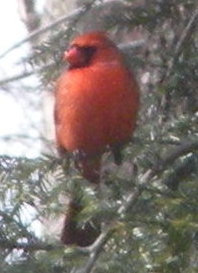 The only bird that I was able to pick out by sight was the Northern Cardinal, seen here and also at right, with two other grayish birds that I could not at the time identify (but stay tuned). There are two cardinals that hang out around our backyard in the Spruce tree near the feeder, and looked just like the ones I remember as a kid in Kentucky.
The only bird that I was able to pick out by sight was the Northern Cardinal, seen here and also at right, with two other grayish birds that I could not at the time identify (but stay tuned). There are two cardinals that hang out around our backyard in the Spruce tree near the feeder, and looked just like the ones I remember as a kid in Kentucky. 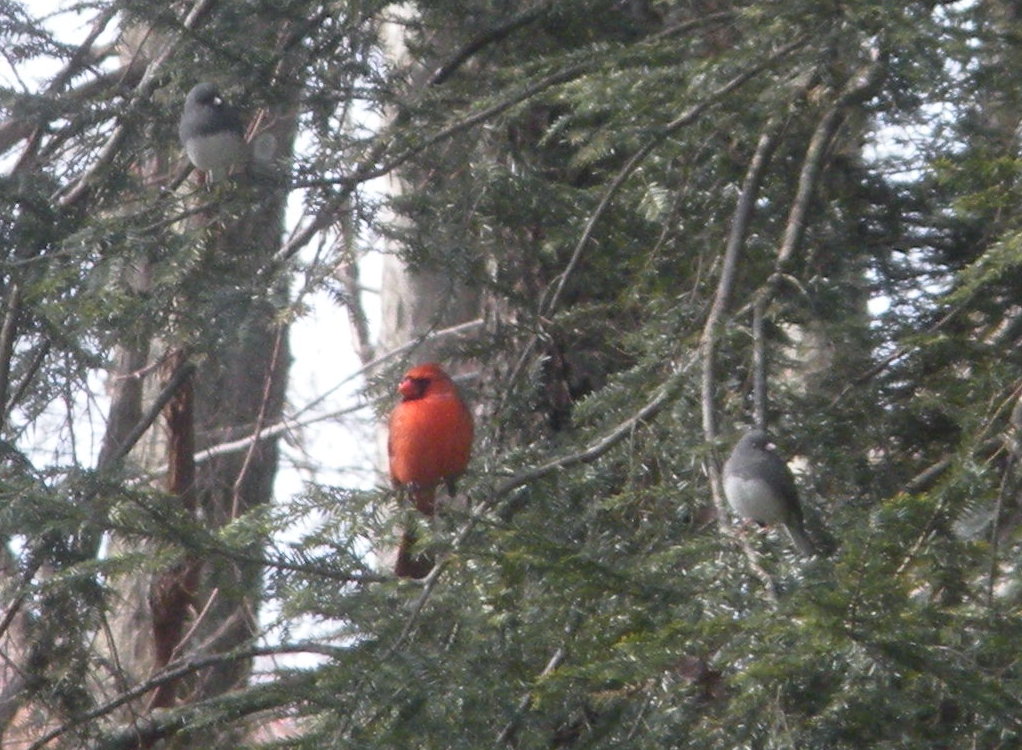 I vaguely recall having a plastic model of a Cardinal that we had to glue together and paint (like a model airplane). The birds were so red they didn’t look real. More cartoon like than anything. With that black mask they always look a bit angry about something. I don’t know why.
I vaguely recall having a plastic model of a Cardinal that we had to glue together and paint (like a model airplane). The birds were so red they didn’t look real. More cartoon like than anything. With that black mask they always look a bit angry about something. I don’t know why.
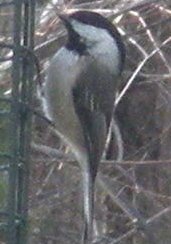 The first bird that I was able to identify with the iBird app was this little guy, the Black Capped Chickadee.
The first bird that I was able to identify with the iBird app was this little guy, the Black Capped Chickadee.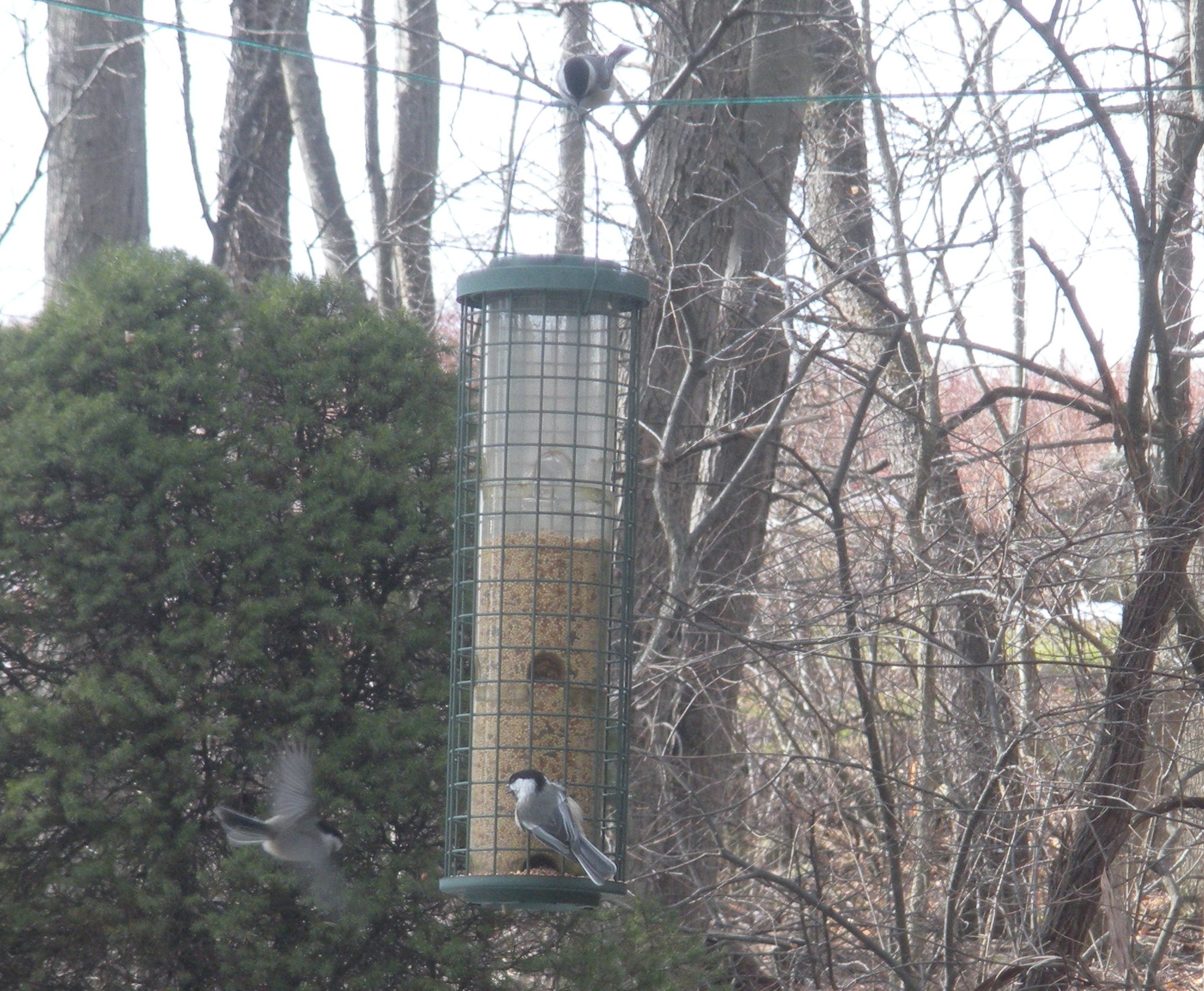 It was pretty distinctive, and with that black cap on its head it didn’t look like much else in the iBird guide. One thing that helped identify a lot of the birds was the wire grid on the bird-feeder whose squares were about an inch on a side, making size estimates pretty easy.
It was pretty distinctive, and with that black cap on its head it didn’t look like much else in the iBird guide. One thing that helped identify a lot of the birds was the wire grid on the bird-feeder whose squares were about an inch on a side, making size estimates pretty easy.
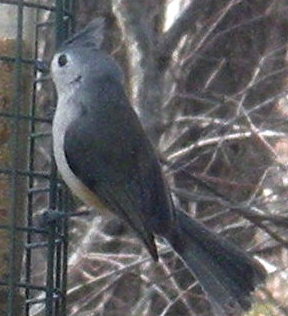 A lot of these little birds seem to stick together, and so this other mini-bird, the Tufted Titmouse, was often seen with his buddies hanging out in the same group at the feeder.
A lot of these little birds seem to stick together, and so this other mini-bird, the Tufted Titmouse, was often seen with his buddies hanging out in the same group at the feeder. 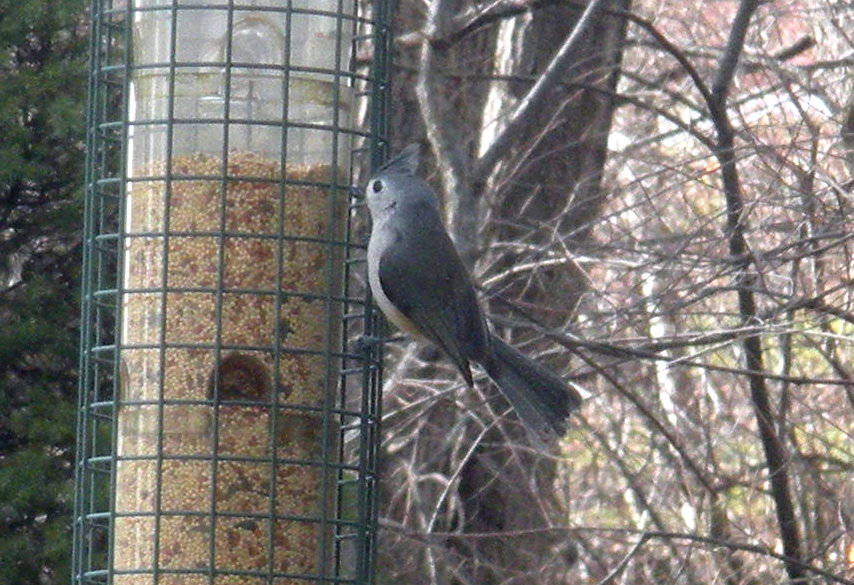 The only way I was able to get a good count was by taking a photograph, as they all kept hopping around trading places, which made it hard to keep track. The iBird app has about 900 North American birds in its database, so to narrow it down I put in that this was a small bird (3-5 inches) with a sort of ruffled topknot on its head and a small beak.
The only way I was able to get a good count was by taking a photograph, as they all kept hopping around trading places, which made it hard to keep track. The iBird app has about 900 North American birds in its database, so to narrow it down I put in that this was a small bird (3-5 inches) with a sort of ruffled topknot on its head and a small beak.
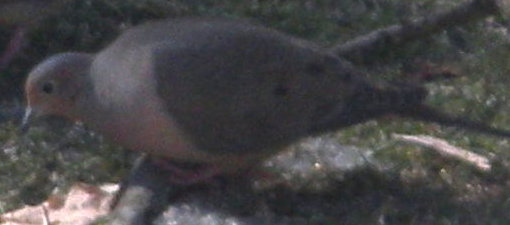 The Mourning Dove was not too hard to identify either. I was pretty sure it was a dove rather than a Rock Pigeon. Getrude Stein never had much to say about doves. Not even “Alas.” They are a thing with feathers as E. Dickinson would say, but they don’t look very hopeful. I guess mourning does that to a bird. Too bad its not a morning dove. What a difference a “U” makes.
The Mourning Dove was not too hard to identify either. I was pretty sure it was a dove rather than a Rock Pigeon. Getrude Stein never had much to say about doves. Not even “Alas.” They are a thing with feathers as E. Dickinson would say, but they don’t look very hopeful. I guess mourning does that to a bird. Too bad its not a morning dove. What a difference a “U” makes.
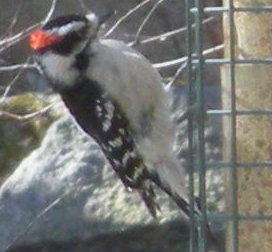 The first four birds were relatively easy, but after that things started getting harder. I knew that this bird was some sort of woodpecker, for example, and had seen it and its companion high up in the trees pecking away since the early fall. With the iBird program I was able to narrow the candidates down to a couple of species, which were the Downy Woodpecker, and the Hairy Woodpecker. At this point however, I was stuck, as the pictures of the two species look virtually identical, with the same red band on the back of their heads, and the same lightning-bolt white stripes on the back.
The first four birds were relatively easy, but after that things started getting harder. I knew that this bird was some sort of woodpecker, for example, and had seen it and its companion high up in the trees pecking away since the early fall. With the iBird program I was able to narrow the candidates down to a couple of species, which were the Downy Woodpecker, and the Hairy Woodpecker. At this point however, I was stuck, as the pictures of the two species look virtually identical, with the same red band on the back of their heads, and the same lightning-bolt white stripes on the back. 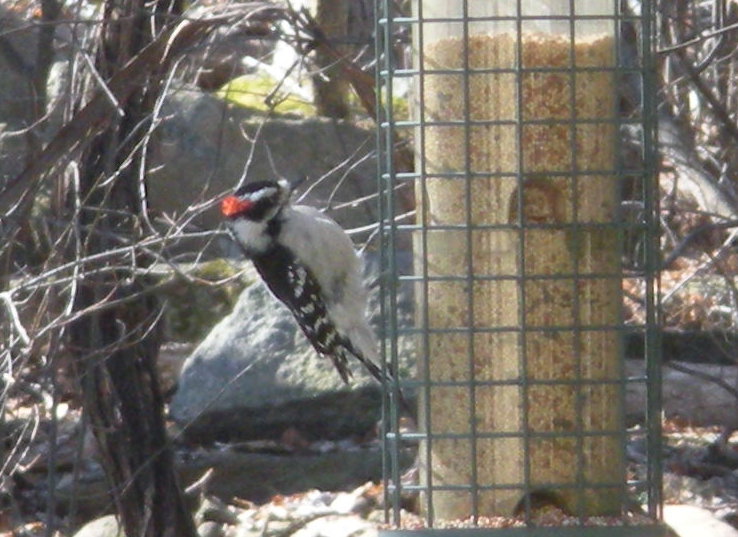 And this was where I started learning a few things about why evolution is such a tricky subject. It turns out that these two species, even though they look like twins, are not genetically related at all (other than being birds). They are, the scientists say, an example of “Convergent Evolution”, in which two completely different species, arriving in the same geographic area, begin to find advantage in looking a lot like each other. The Viceroy butterfly is one such example, which though completely edible to nearby predators, evolved to look just like the poisonous Monarch butterfly. So far as I know, both of these woodpeckers are edible. To make a long story short, once again the one-inch grid on the bird feeder settled the issue, as our bird is clearly no more than four inches long, but the mature Hairy Woodpecker is a “medium” size bird, about 6-8 inches in length. This little Downy Woodpecker we’ve got is also a bit more fuzzy than hairy.
And this was where I started learning a few things about why evolution is such a tricky subject. It turns out that these two species, even though they look like twins, are not genetically related at all (other than being birds). They are, the scientists say, an example of “Convergent Evolution”, in which two completely different species, arriving in the same geographic area, begin to find advantage in looking a lot like each other. The Viceroy butterfly is one such example, which though completely edible to nearby predators, evolved to look just like the poisonous Monarch butterfly. So far as I know, both of these woodpeckers are edible. To make a long story short, once again the one-inch grid on the bird feeder settled the issue, as our bird is clearly no more than four inches long, but the mature Hairy Woodpecker is a “medium” size bird, about 6-8 inches in length. This little Downy Woodpecker we’ve got is also a bit more fuzzy than hairy.
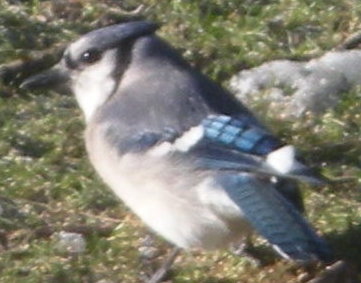 I guess in retrospect this bird should have been a lot easier, but it just points out how much my colorblindness screws things up. I had been searching through the iBird program for some bird that looked a lot like a woodpecker (with its long pointy beak), but which was gray in color, with some dark and white bars on the back. Nothing was coming up that looked at all like this bird.
I guess in retrospect this bird should have been a lot easier, but it just points out how much my colorblindness screws things up. I had been searching through the iBird program for some bird that looked a lot like a woodpecker (with its long pointy beak), but which was gray in color, with some dark and white bars on the back. Nothing was coming up that looked at all like this bird.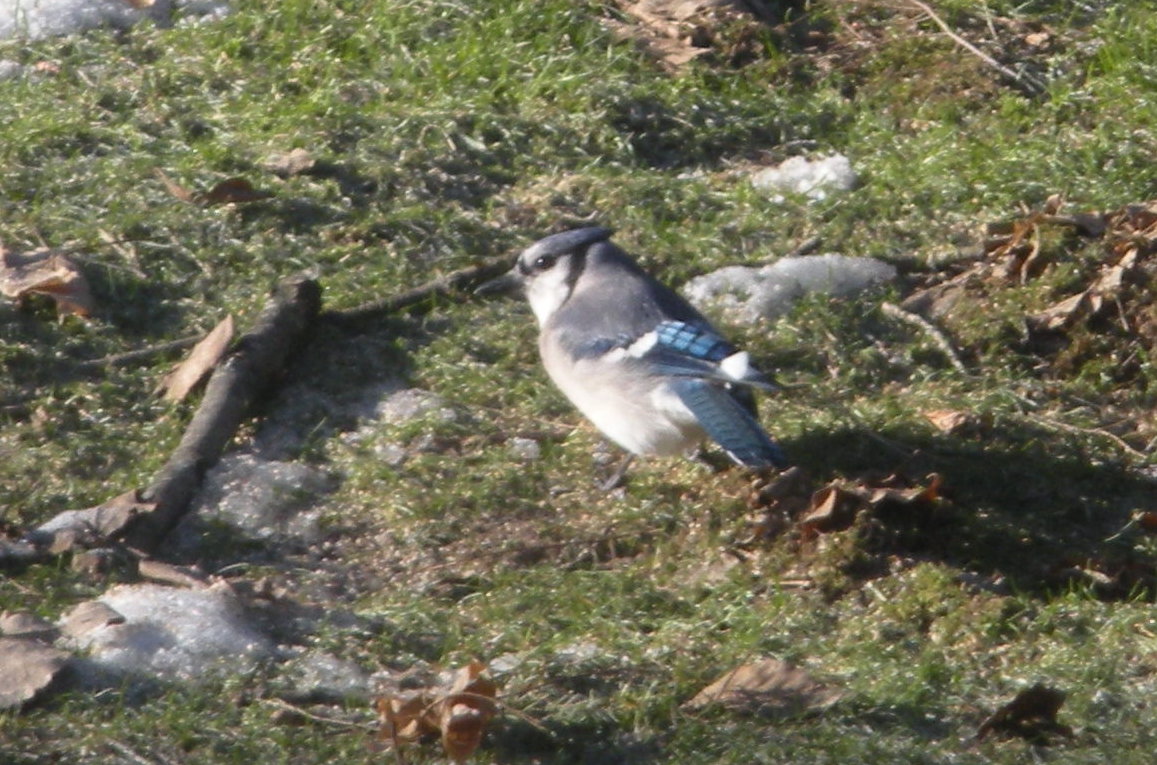 For some reason I had always thought that Blue Jays were a lot more bluish than this (bringing to mind the old line from “Yellow Submarine”, said by one of the Blue Meanies: “funny, you don’t look bluish”). The blue jay in the iBird program looked very blue. Something told me that this thing was a Jay of some sort, and after digging around on the internet I found some pictures of bluejays that matched my bird. Gigi later confirmed that the bird was definitely blue-gray. Still looks gray to me, except for those little squares on the back.
For some reason I had always thought that Blue Jays were a lot more bluish than this (bringing to mind the old line from “Yellow Submarine”, said by one of the Blue Meanies: “funny, you don’t look bluish”). The blue jay in the iBird program looked very blue. Something told me that this thing was a Jay of some sort, and after digging around on the internet I found some pictures of bluejays that matched my bird. Gigi later confirmed that the bird was definitely blue-gray. Still looks gray to me, except for those little squares on the back.
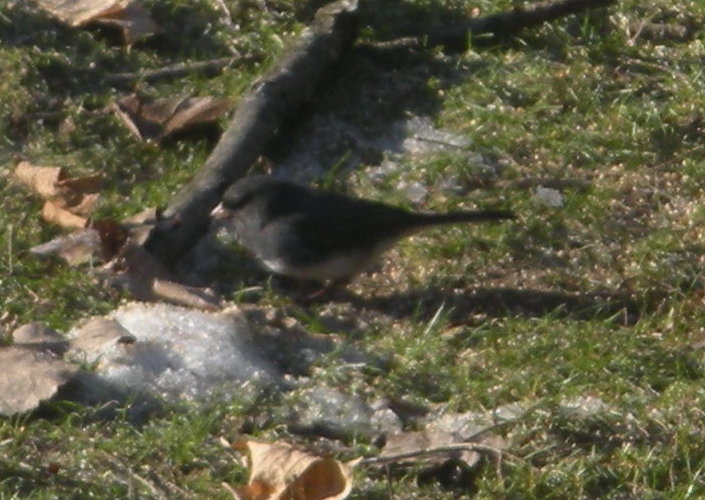 These last two birds were driving me crazy, because I couldn’t find anything like them in iBird, and they were the most numerous of the birds. I guess the problem is that they were so generic looking, just little fat birds with small beaks, one a kind of slate color, the other a vague brownish color with stripes. I had completely given up on identifying them and had already gone online to the Great Backyard Birdcount website to submit my final counts, when the form came up asking me to put in how many of each species I had found.
These last two birds were driving me crazy, because I couldn’t find anything like them in iBird, and they were the most numerous of the birds. I guess the problem is that they were so generic looking, just little fat birds with small beaks, one a kind of slate color, the other a vague brownish color with stripes. I had completely given up on identifying them and had already gone online to the Great Backyard Birdcount website to submit my final counts, when the form came up asking me to put in how many of each species I had found. 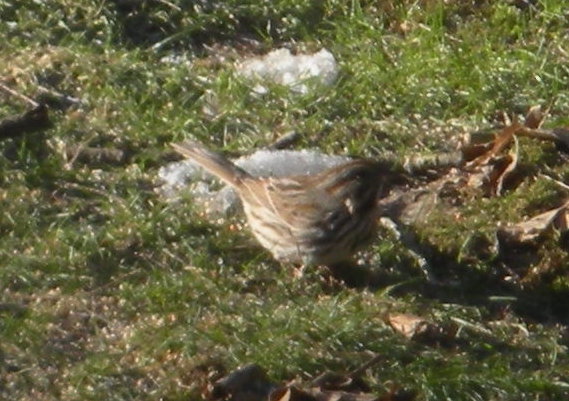 The forms are tailored to the geographic area, and the form that I was given online was for birds in Connecticut. Each line of the form had the name of a bird, which was a link to a popup photo of that bird. Just out of curiosity I starting clicking on each one, and didn’t get too far through the “Sparrow-like” section of birds before I hit both of my mystery birds. The first one was the (slate colored) Dark-eyed Junco, and the other (to the right) was the Song Sparrow. Finally it all made sense. The two birds that sat next to the Northern Cardinal were also slightly larger dark-eyed juncos. Done! Shrink wrap and ship it!
The forms are tailored to the geographic area, and the form that I was given online was for birds in Connecticut. Each line of the form had the name of a bird, which was a link to a popup photo of that bird. Just out of curiosity I starting clicking on each one, and didn’t get too far through the “Sparrow-like” section of birds before I hit both of my mystery birds. The first one was the (slate colored) Dark-eyed Junco, and the other (to the right) was the Song Sparrow. Finally it all made sense. The two birds that sat next to the Northern Cardinal were also slightly larger dark-eyed juncos. Done! Shrink wrap and ship it!
The Final Count
Anyway, for the record, here is the final tally that I submitted to the Great Backyard Birdcount, for today:
Location: South Glastonbury, Connecticut
Starting Timee: 10:00 am, February 16, 2009
Total Birding Time: 2 hours
Estimated Birding Skill: Fair
Snow on the Ground: Less Than 2 inches
- 6 Mourning Doves
- 2 Downy Woodpeckers
- 2 Blue Jays
- 10 Black-capped Chickadees
- 6 Tufted Titmouses (Titmice ?)
- 3 Song Sparrows
- 12 Dark-eyed Juncos (Slate-colored)
- 2 Northern Cardinals
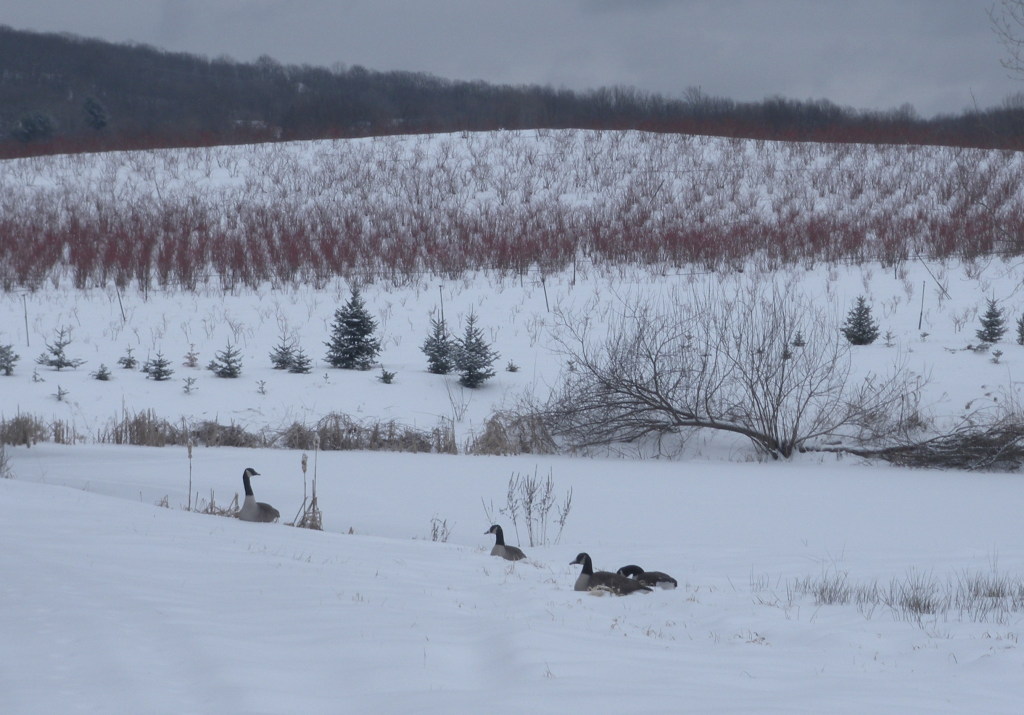 To which, I might add, zero Swans a Swimming, zero Geese a Laying, and zero Golden Ring-Necked Pheasants (which as you all know, is the bird they are talking about in the song when they sing “Five Golden Rings” — the first 7 days are all birds). A few weeks ago, however, I did observe a whole gaggle of Canadian Geese, out along the trail in the Rose’s Berry Farm, and which you can see here and at the beginning of this article. But they weren’t a-laying anything. They just sat there a-honking.
To which, I might add, zero Swans a Swimming, zero Geese a Laying, and zero Golden Ring-Necked Pheasants (which as you all know, is the bird they are talking about in the song when they sing “Five Golden Rings” — the first 7 days are all birds). A few weeks ago, however, I did observe a whole gaggle of Canadian Geese, out along the trail in the Rose’s Berry Farm, and which you can see here and at the beginning of this article. But they weren’t a-laying anything. They just sat there a-honking.
